Related Research Articles

Shenzhou is a spacecraft developed and operated by China to support its crewed spaceflight program, China Manned Space Program. Its design resembles the Russian Soyuz spacecraft, but it is larger in size. The first launch was on 19 November 1999 and the first crewed launch was on 15 October 2003. In March 2005, an asteroid was named 8256 Shenzhou in honour of the spacecraft.
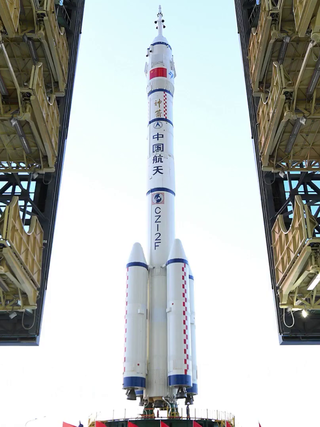
The Long March 2F, also known as the CZ-2F, LM-2F and Shenjian, is a Chinese orbital carrier rocket, part of the Long March 2 rocket family. Designed to launch crewed Shenzhou spacecraft, the Long March 2F is a human-rated two-stage version of the Long March 2E rocket, which in turn was based on the Long March 2C launch vehicle. It is launched from complex SLS at the Jiuquan Satellite Launch Center. The Long March 2F made its maiden flight on 19 November 1999, with the Shenzhou 1 spacecraft. After the flight of Shenzhou 3, CPC General Secretary and President Jiang Zemin named the rocket "Shenjian" meaning "Divine Arrow".
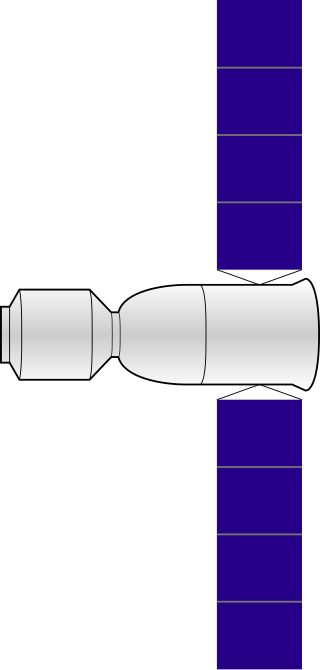
Shenzhou 6 was the second human spaceflight of the Chinese space program, launched on October 12, 2005 on a Long March 2F rocket from the Jiuquan Satellite Launch Center. The Shenzhou spacecraft carried a crew of Fèi Jùnlóng (费俊龙) and Niè Hǎishèng (聂海胜) for five days in low Earth orbit. It launched three days before the second anniversary of China's first human spaceflight, Shenzhou 5.
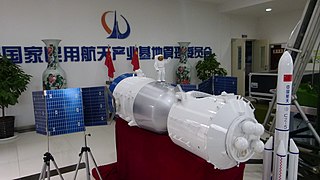
Shenzhou 7 was the third human spaceflight mission of the Chinese space program. The mission, which included the first Chinese extra-vehicular activity (EVA) carried out by crew members Zhai Zhigang and Liu Boming, marked the commencement of the second phase of the Chinese government's Project 921.
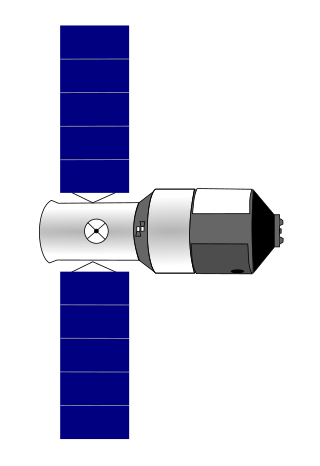
The Tiangong program is China's space program to create a modular space station, comparable to Mir. This program is independent and unconnected to any other international space-active countries. The program is part of the China Manned Space Program that began in 1992. The core module, the Tianhe was finally launched on 29 April 2021 marking the start of the Tiangong Space program deployment.

Tiangong, officially the Tiangong space station, is a permanently crewed space station constructed by China and operated by China Manned Space Agency in low Earth orbit between 340 and 450 km above the surface. It is China's first long-term space station, part of the Tiangong program and the core of the "Third Step" of the China Manned Space Program; it has a pressurised volume of 340 m3, slightly over one third the size of the International Space Station.

The Orlan space suit is a series of semi-rigid one-piece space suit models designed and built by NPP Zvezda. They have been used for spacewalks (EVAs) in the Russian space program, the successor to the Soviet space program, and by space programs of other countries, including NASA.

Shenzhou 8 was an uncrewed flight of China's Shenzhou program, launched on 31 October 2011 UTC, or 1 November 2011 in China, by a Long March 2F rocket which lifted off from the Jiuquan Satellite Launch Center.

Shenzhou 9 was the fourth crewed spacecraft flight of China's Shenzhou program, launched at 18:37:24 CST, 16 June 2012. Shenzhou 9 was the second spacecraft and first crewed mission and expedition to dock with the Tiangong-1 space station, which took place on 18 June. The Shenzhou 9 spacecraft landed at 10:01:16 CST on 29 June in the Inner Mongolia Autonomous Region. The mission's crew included the first Chinese female astronaut, Liu Yang. The next mission was Shenzhou 10, which launched on 11 June 2013.

Shenzhou 10 was a crewed spaceflight of China's Shenzhou program that was launched on 11 June 2013. It was China's fifth crewed space mission. The mission had a crew of three astronauts: Nie Haisheng, who was mission commander and previously flew on Shenzhou 6; Zhang Xiaoguang, a former PLAAF squadron commander who conducted the rendezvous and docking; and Wang Yaping, the second Chinese female astronaut. The Shenzhou spacecraft docked with the Tiangong-1 trial space laboratory module on 13 June, and the astronauts performed physical, technological, and scientific experiments while on board. Shenzhou 10 was the 2nd and final expedition and mission to Tiangong-1 in this portion of the Tiangong program. On 26 June 2013, after a series of successful docking tests, Shenzhou 10 returned to Earth.

Ma is a Chinese family name. The surname literally means "horse". As of 2006, it ranks as the 14th most common Chinese surname in mainland China and the most common surname within the Chinese Muslim community, specifically the Hui people, Dongxiang people and Salar people. In 2019 it was the 13th most common surname in mainland China. A 2013 study found it to be the 13th most common, shared by 17,200,000 people or 1.290% of the population, with the province with the most being Henan. It is the 52nd name on the Hundred Family Surnames poem.

The China Manned Space Program, also known as Project 921 is a space program developed by the People's Republic of China and run by the China Manned Space Agency (CMSA) under the Equipment Development Department of the Central Military Commission, designed to develop and enhance human spaceflight capabilities for China. It was approved on 21 September 1992 and has been in operation ever since. The CMS commander and director are currently Xu Xueqiang and Zhou Jianping respectively; the latter has held this position since 2006, after taking over from Wang Yongzhi, who served as the first director from 1992 to 2006.

Zhang Qingwei is a Chinese politician, business executive, and aerospace engineer, who is a vice chairperson of the Standing Committee of the National People's Congress. He was formerly the Communist Party Secretary of Hunan, the Communist Party Secretary of Heilongjiang, Governor of Hebei, and chairperson of the Commission for Science, Technology and Industry for National Defense (COSTIND). Prior to his government career he was president of China Aerospace Science and Technology Corporation (CASC) and chairman of Comac, an aerospace manufacturer.

Tiangong-1 was China's first prototype space station. It orbited Earth from September 2011 to April 2018, serving as both a crewed laboratory and an experimental testbed to demonstrate orbital rendezvous and docking capabilities during its two years of active operational life.

Tiangong-2 was a Chinese space laboratory and part of the Project 921-2 space station program. Tiangong-2 was launched on 15 September 2016. It was deorbited as planned on 19 July 2019.
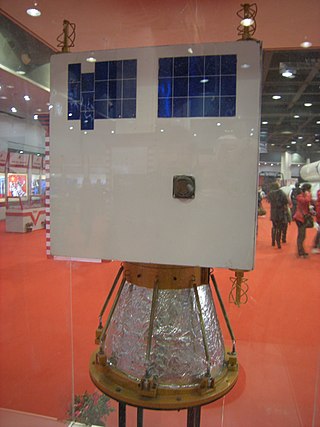
Banxing or BX-1, is a small Chinese technology development satellite which was deployed from the Shenzhou 7 spacecraft at 11:27 GMT on 27 September 2008. Prior to deployment, the satellite was mounted on top of the Shenzhou 7 orbital module.
The Chinese Docking Mechanism is a spacecraft docking mechanism based on the Androgynous Peripheral Attach System (APAS). There have been contradicting reports by the Chinese on its compatibility with APAS. It is used by Shenzhou spacecraft, beginning with an uncrewed Shenzhou 8, to dock to Tiangong-1. Subsequent crewed missions docked with the Tiangong-1, Tiangong-2 and the Tiangong space station. Similar docking mechanism was also introduced to the Tianzhou cargo spacecraft. Tianzhou 1 was the first cargo spacecraft which docked with the Tiangong-2. It has a circular transfer passage that has a diameter of 800 mm (31 in). The androgynous variant has a mass of 310 kg and the non-androgynous variant has a mass of 200 kg.
Ma Jianrong is a Chinese billionaire businessman in the textile industry, and the chairman of Shenzhou International Group Holdings Limited, a knitwear and garments manufacturer based in China. As of August 2023, his net worth was estimated at US$7.3 billion.
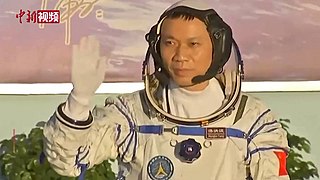
Senior Colonel Tang Hongbo is a Chinese fighter pilot and People's Liberation Army Astronaut Corps (PLAAC) taikonaut. He flew on his first spaceflight to the Tiangong space station as a part of the Shenzhou 12 mission.
References
- ↑ "About Shenzhou". shenzhouintl. Retrieved 22 October 2015.
- 1 2 "Ma Jianrong". Forbes. Retrieved 21 October 2015.